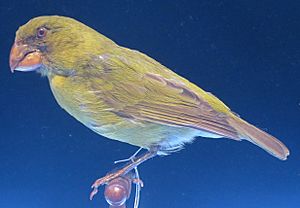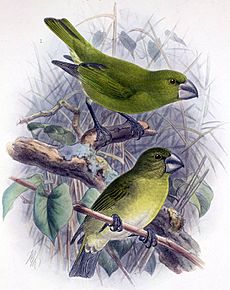Kona grosbeak facts for kids
Quick facts for kids Kona grosbeak |
|
|---|---|
 |
|
| Specimen in Bishop Museum, Honolulu | |
| Conservation status | |
| Scientific classification | |
| Genus: |
Chloridops
|
| Species: |
kona
|
| Synonyms | |
|
Psittirostra kona (Wilson, 1888) |
|
The Kona grosbeak (Chloridops kona) was a type of Hawaiian honeycreeper, a bird that is now extinct. This bird lived only in the naio (Myoporum sandwicense) forests on the Big Island of Hawaii. It preferred areas with rough lava rock, high up in the mountains (about 1,400 to 1,500 meters or 4,600 to 4,900 feet high) near the Kona area.
Even when it was first found, the Kona grosbeak was very rare. It lived in a tiny area, only about 10 square kilometers (4 square miles). The last time anyone saw or collected one was in 1894. We don't know exactly why it became extinct. Scientists have found fossils of similar birds on other Hawaiian islands like Kauai, Oahu, and Maui. The local people didn't know about this bird, so it doesn't have a name in the Hawaiian language.
Contents
What the Kona Grosbeak Looked Like
The Kona grosbeak was a medium-sized, somewhat plump bird, about 15 centimeters (6 inches) long. Its feathers were a dull olive green color. Both male and female birds looked the same. It had a large head and a very big, brownish-gray beak.
What the Kona Grosbeak Ate
The Kona grosbeak was a frugivore, meaning it mostly ate fruit. Its large beak was perfect for cracking open the very hard shells of dried naio (Myoporum sandwicense) fruits. It might have also eaten green naio fruits and leaves. Sometimes, it probably ate softer fruits too, like those from the ʻieʻ plant (Freycinetia arborea). Young Kona grosbeaks likely ate invertebrates, like insects.
Observations by Scott Wilson
Scott Barchard Wilson, a bird expert, was one of the few people who saw Kona grosbeaks in the wild. He wrote about his experiences in a science paper called The Ibis in 1893.
Wilson described the Kona grosbeak as a quiet, slow, and lonely bird. He said its main purpose seemed to be "to eat." Its food was the tiny seeds found inside the very hard fruits of the naio tree. The bird spent most of its time cracking these tough shells with its powerful beak and heavy head. Wilson noted that you could hear the constant cracking sound from far away, which made the bird easier to find.
He mostly found these birds on rough lava fields, but they sometimes went into open areas of the forest. Wilson never heard the Kona grosbeak sing. He only once saw a male and female bird chasing each other, which was unusual for them. He also noticed that their beaks were often dirty with a brown substance, probably from the naio trees.
See also
 In Spanish: Certiola Kona para niños
In Spanish: Certiola Kona para niños



